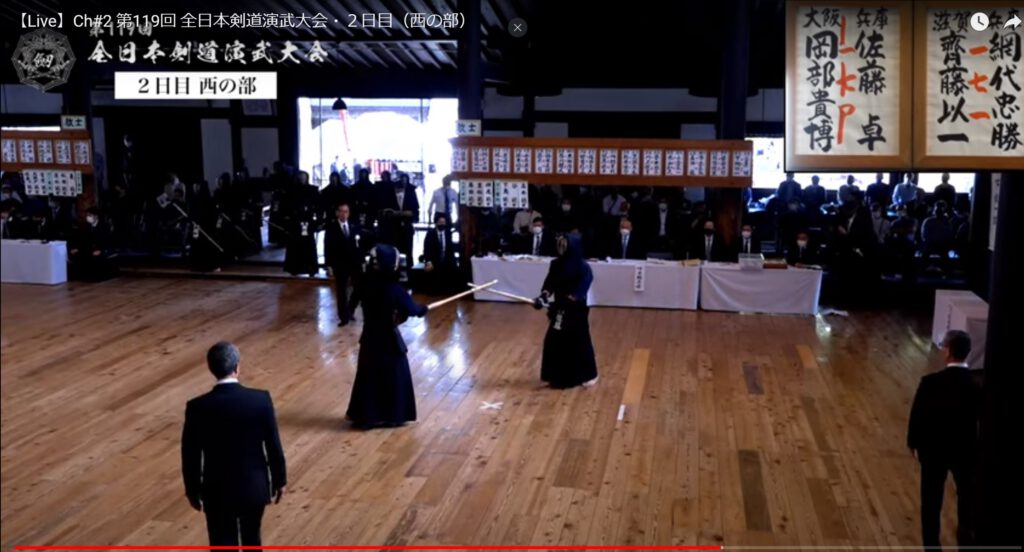Expressions such aus budōsai, enbukai, enbu taikai etc. are regularly seen in Okinawa karate and kobudo today. They are derivates of an original terminology used in 1895 at what is now known as Kyōto Meet. Okinawans were dispatched to the Kyōto Meet as early as 1908 where they also performed karate, which was and is a source of great pride for Okinawa. Also, in 1939, a martial arts training hall was built in Okinawa and a large demonstration of kata of karate kobudo took place. However, large-scale karate kobudo meets on Okinawa truly began only long in the postwar era.
On the other hands, if you ever attended, participated in, or watched a large enbukai or budōsai in Okinawa, such as at the Prefectural Budōkan or the Karate Kaikan, you will have noticed how smooth their organisation is, how everything just runs like a clockwork, and how everyone is following protocol and beyond to implement a perfect event without interruptions. In fact, it is really the singlemost impressive thing in this kind of events. How come?
Okinawans were experienced in the organization and holding of large-scale athletic meets since the late 19th century. The first grand athletic meet in Okinawa took place already in 1887 at Kobagura military drill ground to welcome Minister of Education, Mori Arinori. As a result, in the same year military drill was added to the middle school in Shuri, and later at the normal school as well. Officers or NCO of the Kumamoto Garrison stationed in Okinawa were entrusted with instruction. Since that time, athletic meets were held all over Okinawa Prefecture. At the grand athletic meet of 1901, more than 10,000 students participated, singing the kimigayo (Japanese national anthem) in unison as a starting signal.
But when it comes to bujutsu / budō meets in Japan, the Kyōto Meet is the “Mother of All Enbu Taikai.”
[The following is my translation of the Japanese language Wikipedia page for the topic]
Kyōto Meet
The All-Japan Kendo Demonstration Meet (zen nihon kendō enbu taikai) is a national kendō tournament held at the former Butokuden in Kyōto during the consecutive holidays in May every year. Commonly known as the Kyōto Meet, it is the most traditional and prestigious kendō tournament. Demonstrations of kata of iaidō, jōdō, naginata, and kobudō are also performed.
History
In 1895, the Dai Nippon Butokukai held the “Festival of Military Virtues and Grand Demonstration Meet” at Heian Shrine for the first time. Until 1933, a certificate of refined training (seirensho) was awarded to those who demonstrated excellent performances (=matches) every year.
In March 1899, the Butokuden was completed to the northwest of Heian Shrine. In connection with the historical fact that Emperor Kanmu ordered the provinces to gather military artists (bugeisha) in March 796, it was decided to hold the “Festival of Military Virtues” on May 4, which is the day converted to the new calendar.
In 1943, the tournament was suspended due to the Pacific War, and Japan was defeated in 1945. In 1946, Dai Nippon Butokukai was dissolved by Occupation Forces Directive.
In 1952, when the occupation was lifted, the All-Japan Kendo Federation was established as the de facto successor to the Dai Nippon Butokukai. The following day, May 4, 1953, the tournament was revived for the first time in ten years as the first national kendō tournament after the war, and it continues to this day. 2023 is the 119th edition of the tournament.
With over 3,000 participants each year, it is the largest kendō tournament.
Eligibility
- Those who are registered with the All-Japan Kendo Federation in kendō, iaidō, and jōdō and are renshi 6th dan or higher.
- Those who are registered with the All-Japan Naginata Federation and are renshi or higher.
- Various kata (kobudō) by renshi 6th dan or higher.
Match format
Only one match (shiai) per person. Match time is 2 minutes, three-point match rules. If there is no winner within the time limit, it will be a draw. Matches between hanshi are exhibition matches and are not judged as victory or defeat.
It is different from competitions such as a championship series, where participants compete about their standing. Instead, it is a martial arts demonstration meet (enbu taikai) that showcases the results of one year of practice since the previous year’s meet.
Sponsorship
- Sponsorship / organizer: All-Japan Kendo Federation (incorporated foundation)
- Supervision: Kyoto Prefecture Kendo Federation (incorporated foundation)
- Patronage: Kyoto Prefecture, Kyoto City, Kyoto Prefectural Board of Education, Kyoto City Board of Education, Kyoto Newspaper
Afterword
Epilogue
According to Umezu and Hasegawa (2017),
“The peculiarities of this meet are:
(1) Although it adopts the competition rules of kendō, it does not place absolute value on victory.
(2) Swordsmen who are over 100 years old are participating without retiring from “active duty.”
(3) There is a tacit understanding to appropriately recognize the value of both the event and the place.”
It is quite noticable that the athmosphere is very different from most Okinawan karate and kobudō dōjō. This is partly due to the practice modus, which is match (shiai) in the case of kendō here. Can you notice other differences?
© 2023, Andreas Quast. All rights reserved.

